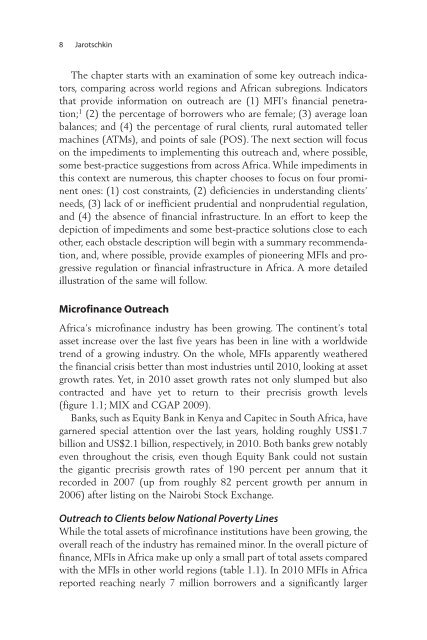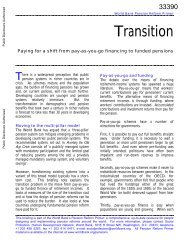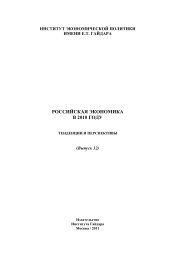Financial Sector Development in Africa: Opportunities ... - World Bank
Financial Sector Development in Africa: Opportunities ... - World Bank
Financial Sector Development in Africa: Opportunities ... - World Bank
Create successful ePaper yourself
Turn your PDF publications into a flip-book with our unique Google optimized e-Paper software.
8 Jarotschk<strong>in</strong><br />
The chapter starts with an exam<strong>in</strong>ation of some key outreach <strong>in</strong>dicators,<br />
compar<strong>in</strong>g across world regions and <strong>Africa</strong>n subregions. Indicators<br />
that provide <strong>in</strong>formation on outreach are (1) MFI’s f<strong>in</strong>ancial penetration;<br />
1 (2) the percentage of borrowers who are female; (3) average loan<br />
balances; and (4) the percentage of rural clients, rural automated teller<br />
mach<strong>in</strong>es (ATMs), and po<strong>in</strong>ts of sale (POS). The next section will focus<br />
on the impediments to implement<strong>in</strong>g this outreach and, where possible,<br />
some best-practice suggestions from across <strong>Africa</strong>. While impediments <strong>in</strong><br />
this context are numerous, this chapter chooses to focus on four prom<strong>in</strong>ent<br />
ones: (1) cost constra<strong>in</strong>ts, (2) deficiencies <strong>in</strong> understand<strong>in</strong>g clients’<br />
needs, (3) lack of or <strong>in</strong>efficient prudential and nonprudential regulation,<br />
and (4) the absence of f<strong>in</strong>ancial <strong>in</strong>frastructure. In an effort to keep the<br />
depiction of impediments and some best-practice solutions close to each<br />
other, each obstacle description will beg<strong>in</strong> with a summary recommendation,<br />
and, where possible, provide examples of pioneer<strong>in</strong>g MFIs and progressive<br />
regulation or f<strong>in</strong>ancial <strong>in</strong>frastructure <strong>in</strong> <strong>Africa</strong>. A more detailed<br />
illustration of the same will follow.<br />
Microf<strong>in</strong>ance Outreach<br />
<strong>Africa</strong>’s microf<strong>in</strong>ance <strong>in</strong>dustry has been grow<strong>in</strong>g. The cont<strong>in</strong>ent’s total<br />
asset <strong>in</strong>crease over the last five years has been <strong>in</strong> l<strong>in</strong>e with a worldwide<br />
trend of a grow<strong>in</strong>g <strong>in</strong>dustry. On the whole, MFIs apparently weathered<br />
the f<strong>in</strong>ancial crisis better than most <strong>in</strong>dustries until 2010, look<strong>in</strong>g at asset<br />
growth rates. Yet, <strong>in</strong> 2010 asset growth rates not only slumped but also<br />
contracted and have yet to return to their precrisis growth levels<br />
( figure 1.1; MIX and CGAP 2009).<br />
<strong>Bank</strong>s, such as Equity <strong>Bank</strong> <strong>in</strong> Kenya and Capitec <strong>in</strong> South <strong>Africa</strong>, have<br />
garnered special attention over the last years, hold<strong>in</strong>g roughly US$1.7<br />
billion and US$2.1 billion, respectively, <strong>in</strong> 2010. Both banks grew notably<br />
even throughout the crisis, even though Equity <strong>Bank</strong> could not susta<strong>in</strong><br />
the gigantic precrisis growth rates of 190 percent per annum that it<br />
recorded <strong>in</strong> 2007 (up from roughly 82 percent growth per annum <strong>in</strong><br />
2006) after list<strong>in</strong>g on the Nairobi Stock Exchange.<br />
Outreach to Clients below National Poverty L<strong>in</strong>es<br />
While the total assets of microf<strong>in</strong>ance <strong>in</strong>stitutions have been grow<strong>in</strong>g, the<br />
overall reach of the <strong>in</strong>dustry has rema<strong>in</strong>ed m<strong>in</strong>or. In the overall picture of<br />
f<strong>in</strong>ance, MFIs <strong>in</strong> <strong>Africa</strong> make up only a small part of total assets compared<br />
with the MFIs <strong>in</strong> other world regions (table 1.1). In 2010 MFIs <strong>in</strong> <strong>Africa</strong><br />
reported reach<strong>in</strong>g nearly 7 million borrowers and a significantly larger







